Essay on the Management of Non-Tunneled Dialysis Catheters
VerifiedAdded on 2023/06/05
|18
|4921
|378
Essay
AI Summary
This essay provides a comprehensive overview of the management of non-tunneled dialysis catheters, focusing on the critical aspects of insertion, potential complications, and the implementation of effective learning guidelines within an emergency dialysis unit. The essay emphasizes the importance of patient safety and the rationale for establishing a teaching resource to ensure the correct procedures for catheter insertion and removal. It highlights the various factors that can lead to mechanical complications, such as incorrect positioning and faulty insertion techniques, and the potential adverse effects on patient health. The essay also delves into the application of adult learning theories, such as Knowles' andragogy, to create an interactive and cooperative learning environment. It further addresses the barriers to effective learning, including the need for sterilization and the management of patient-specific difficulties. The essay concludes by emphasizing the importance of evaluation through practical examinations, feedback interviews, and follow-up procedures to enhance the effectiveness of the learning resource and ensure continuous improvement in the management of non-tunneled dialysis catheters.
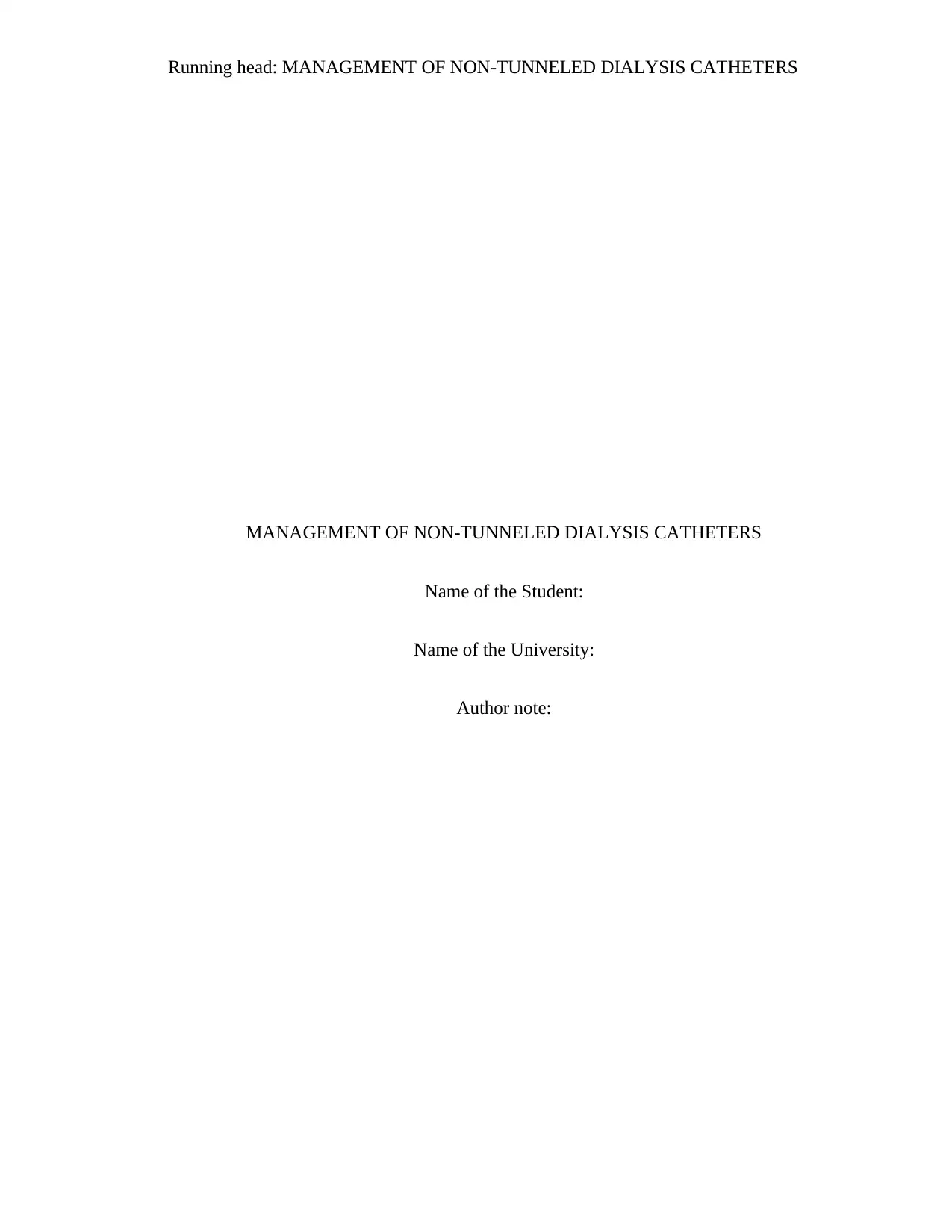
Running head: MANAGEMENT OF NON-TUNNELED DIALYSIS CATHETERS
MANAGEMENT OF NON-TUNNELED DIALYSIS CATHETERS
Name of the Student:
Name of the University:
Author note:
MANAGEMENT OF NON-TUNNELED DIALYSIS CATHETERS
Name of the Student:
Name of the University:
Author note:
Paraphrase This Document
Need a fresh take? Get an instant paraphrase of this document with our AI Paraphraser
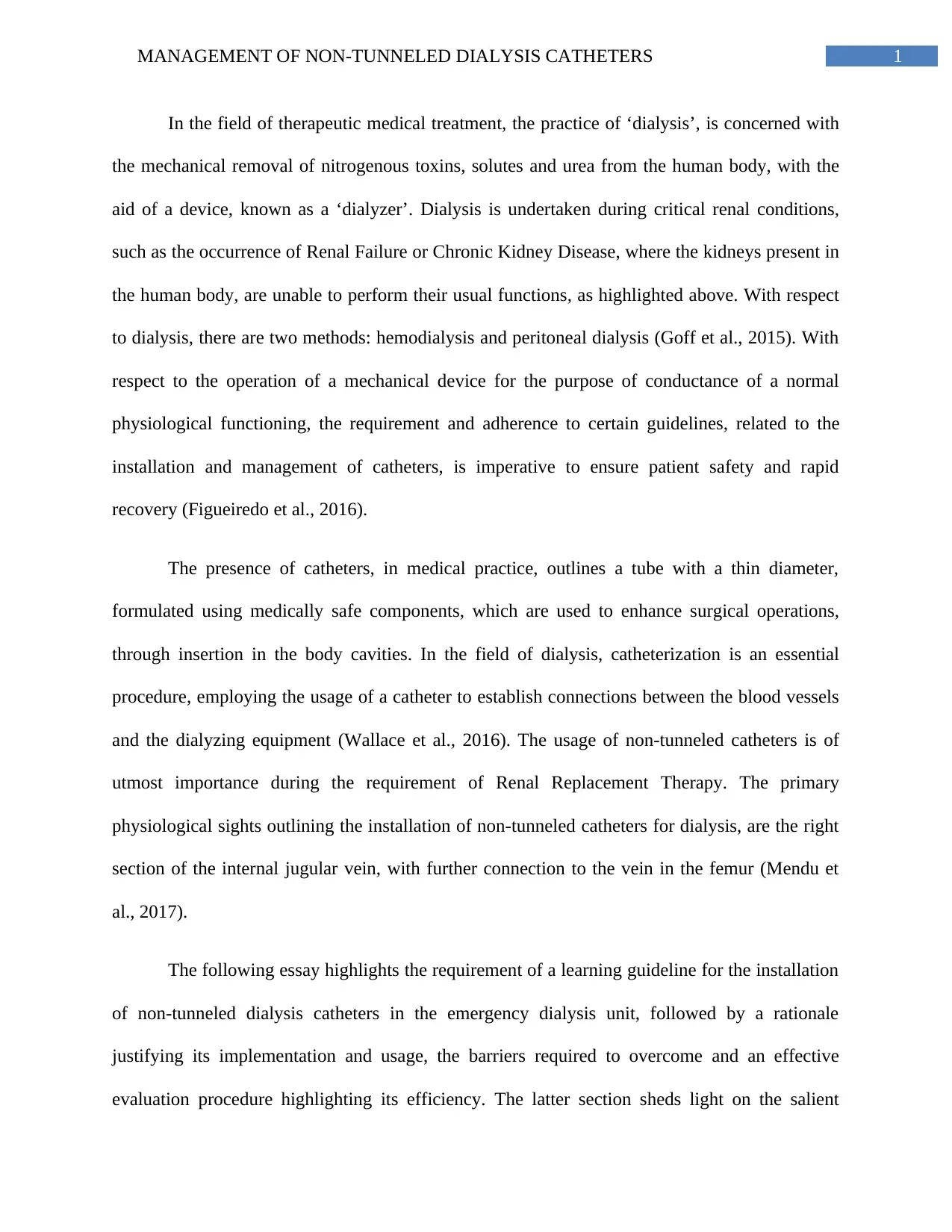
1MANAGEMENT OF NON-TUNNELED DIALYSIS CATHETERS
In the field of therapeutic medical treatment, the practice of ‘dialysis’, is concerned with
the mechanical removal of nitrogenous toxins, solutes and urea from the human body, with the
aid of a device, known as a ‘dialyzer’. Dialysis is undertaken during critical renal conditions,
such as the occurrence of Renal Failure or Chronic Kidney Disease, where the kidneys present in
the human body, are unable to perform their usual functions, as highlighted above. With respect
to dialysis, there are two methods: hemodialysis and peritoneal dialysis (Goff et al., 2015). With
respect to the operation of a mechanical device for the purpose of conductance of a normal
physiological functioning, the requirement and adherence to certain guidelines, related to the
installation and management of catheters, is imperative to ensure patient safety and rapid
recovery (Figueiredo et al., 2016).
The presence of catheters, in medical practice, outlines a tube with a thin diameter,
formulated using medically safe components, which are used to enhance surgical operations,
through insertion in the body cavities. In the field of dialysis, catheterization is an essential
procedure, employing the usage of a catheter to establish connections between the blood vessels
and the dialyzing equipment (Wallace et al., 2016). The usage of non-tunneled catheters is of
utmost importance during the requirement of Renal Replacement Therapy. The primary
physiological sights outlining the installation of non-tunneled catheters for dialysis, are the right
section of the internal jugular vein, with further connection to the vein in the femur (Mendu et
al., 2017).
The following essay highlights the requirement of a learning guideline for the installation
of non-tunneled dialysis catheters in the emergency dialysis unit, followed by a rationale
justifying its implementation and usage, the barriers required to overcome and an effective
evaluation procedure highlighting its efficiency. The latter section sheds light on the salient
In the field of therapeutic medical treatment, the practice of ‘dialysis’, is concerned with
the mechanical removal of nitrogenous toxins, solutes and urea from the human body, with the
aid of a device, known as a ‘dialyzer’. Dialysis is undertaken during critical renal conditions,
such as the occurrence of Renal Failure or Chronic Kidney Disease, where the kidneys present in
the human body, are unable to perform their usual functions, as highlighted above. With respect
to dialysis, there are two methods: hemodialysis and peritoneal dialysis (Goff et al., 2015). With
respect to the operation of a mechanical device for the purpose of conductance of a normal
physiological functioning, the requirement and adherence to certain guidelines, related to the
installation and management of catheters, is imperative to ensure patient safety and rapid
recovery (Figueiredo et al., 2016).
The presence of catheters, in medical practice, outlines a tube with a thin diameter,
formulated using medically safe components, which are used to enhance surgical operations,
through insertion in the body cavities. In the field of dialysis, catheterization is an essential
procedure, employing the usage of a catheter to establish connections between the blood vessels
and the dialyzing equipment (Wallace et al., 2016). The usage of non-tunneled catheters is of
utmost importance during the requirement of Renal Replacement Therapy. The primary
physiological sights outlining the installation of non-tunneled catheters for dialysis, are the right
section of the internal jugular vein, with further connection to the vein in the femur (Mendu et
al., 2017).
The following essay highlights the requirement of a learning guideline for the installation
of non-tunneled dialysis catheters in the emergency dialysis unit, followed by a rationale
justifying its implementation and usage, the barriers required to overcome and an effective
evaluation procedure highlighting its efficiency. The latter section sheds light on the salient

2MANAGEMENT OF NON-TUNNELED DIALYSIS CATHETERS
features of the teaching and training guidelines regarding the management of non-tunneled
dialysis catheters in an emergency dialysis unit.
With respect to the usage of non-tunneled catheters in dialysis, a number of
complications are associated, which are typically related due to implementation of incorrect
insertion procedures, and are not due to infectious causes. The insertion process of non-tunneled
catheters are associated with the vascular region of the human body, and hence, the occurrence
of complications or malfunctions, due to faulty insertion techniques, are prevalent. The
occurrence of physiological complications in the patients, citing mechanical causative factors,
are primarily present during the first seven days after insertion (Clark et al., 2016). Some of the
factors influencing distorted mechanical insertion, are associated with faulty positioning of the
patient, distorted position of the tip of the catheter, as well as kinking of the same. such faulty
procedures may result in fatal complications affecting the health of the patient, and include
injury to the vascular region, occurrence of large clots in the blood vessels or hematoma,
irregular heart rhythm or arrhythmia, profuse internal bleeding and embolism (Mendu et al.,
2017). Hence, in accordance to the occurrence of such complications, the assurance of optimum
health and safety of the patient undergoing dialysis and catheterization outlines the principle
rationale of this teaching guideline related to the management of non-tunneled catheter dialysis
in the emergency dialysis unit (Chopra et al., 2015).
The rationale behind using this teaching tool, is for the assurance of provision of safe and
quality treatment practices, in order to ensure optimum health and recovery for the patient
(McArdle et al., 2017). With respect to this guideline, the teaching plan will require the
procurement and utilization of several tools, for the purpose of its effective implementation. The
individual involved in the education of the personnel, would most importantly require the
features of the teaching and training guidelines regarding the management of non-tunneled
dialysis catheters in an emergency dialysis unit.
With respect to the usage of non-tunneled catheters in dialysis, a number of
complications are associated, which are typically related due to implementation of incorrect
insertion procedures, and are not due to infectious causes. The insertion process of non-tunneled
catheters are associated with the vascular region of the human body, and hence, the occurrence
of complications or malfunctions, due to faulty insertion techniques, are prevalent. The
occurrence of physiological complications in the patients, citing mechanical causative factors,
are primarily present during the first seven days after insertion (Clark et al., 2016). Some of the
factors influencing distorted mechanical insertion, are associated with faulty positioning of the
patient, distorted position of the tip of the catheter, as well as kinking of the same. such faulty
procedures may result in fatal complications affecting the health of the patient, and include
injury to the vascular region, occurrence of large clots in the blood vessels or hematoma,
irregular heart rhythm or arrhythmia, profuse internal bleeding and embolism (Mendu et al.,
2017). Hence, in accordance to the occurrence of such complications, the assurance of optimum
health and safety of the patient undergoing dialysis and catheterization outlines the principle
rationale of this teaching guideline related to the management of non-tunneled catheter dialysis
in the emergency dialysis unit (Chopra et al., 2015).
The rationale behind using this teaching tool, is for the assurance of provision of safe and
quality treatment practices, in order to ensure optimum health and recovery for the patient
(McArdle et al., 2017). With respect to this guideline, the teaching plan will require the
procurement and utilization of several tools, for the purpose of its effective implementation. The
individual involved in the education of the personnel, would most importantly require the
⊘ This is a preview!⊘
Do you want full access?
Subscribe today to unlock all pages.

Trusted by 1+ million students worldwide
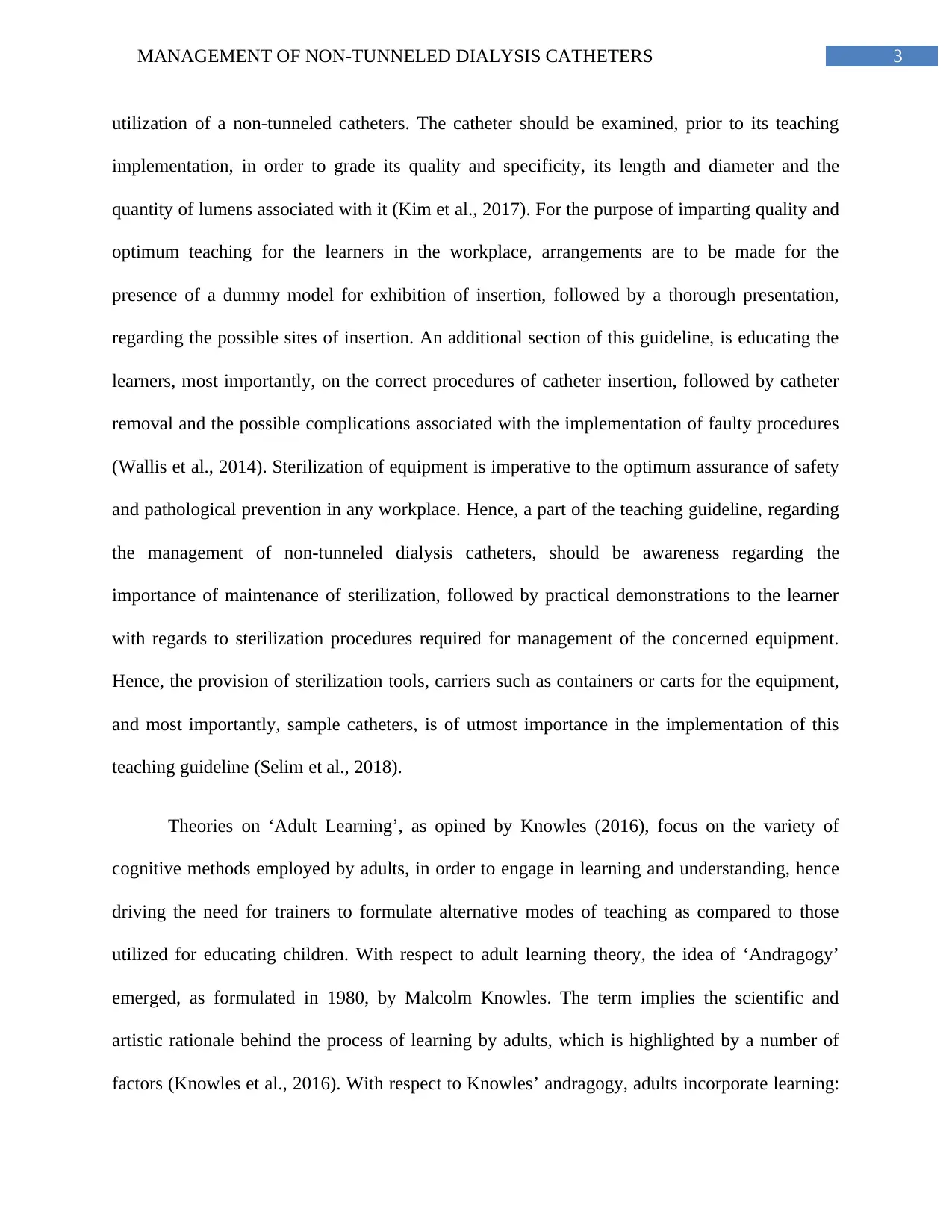
3MANAGEMENT OF NON-TUNNELED DIALYSIS CATHETERS
utilization of a non-tunneled catheters. The catheter should be examined, prior to its teaching
implementation, in order to grade its quality and specificity, its length and diameter and the
quantity of lumens associated with it (Kim et al., 2017). For the purpose of imparting quality and
optimum teaching for the learners in the workplace, arrangements are to be made for the
presence of a dummy model for exhibition of insertion, followed by a thorough presentation,
regarding the possible sites of insertion. An additional section of this guideline, is educating the
learners, most importantly, on the correct procedures of catheter insertion, followed by catheter
removal and the possible complications associated with the implementation of faulty procedures
(Wallis et al., 2014). Sterilization of equipment is imperative to the optimum assurance of safety
and pathological prevention in any workplace. Hence, a part of the teaching guideline, regarding
the management of non-tunneled dialysis catheters, should be awareness regarding the
importance of maintenance of sterilization, followed by practical demonstrations to the learner
with regards to sterilization procedures required for management of the concerned equipment.
Hence, the provision of sterilization tools, carriers such as containers or carts for the equipment,
and most importantly, sample catheters, is of utmost importance in the implementation of this
teaching guideline (Selim et al., 2018).
Theories on ‘Adult Learning’, as opined by Knowles (2016), focus on the variety of
cognitive methods employed by adults, in order to engage in learning and understanding, hence
driving the need for trainers to formulate alternative modes of teaching as compared to those
utilized for educating children. With respect to adult learning theory, the idea of ‘Andragogy’
emerged, as formulated in 1980, by Malcolm Knowles. The term implies the scientific and
artistic rationale behind the process of learning by adults, which is highlighted by a number of
factors (Knowles et al., 2016). With respect to Knowles’ andragogy, adults incorporate learning:
utilization of a non-tunneled catheters. The catheter should be examined, prior to its teaching
implementation, in order to grade its quality and specificity, its length and diameter and the
quantity of lumens associated with it (Kim et al., 2017). For the purpose of imparting quality and
optimum teaching for the learners in the workplace, arrangements are to be made for the
presence of a dummy model for exhibition of insertion, followed by a thorough presentation,
regarding the possible sites of insertion. An additional section of this guideline, is educating the
learners, most importantly, on the correct procedures of catheter insertion, followed by catheter
removal and the possible complications associated with the implementation of faulty procedures
(Wallis et al., 2014). Sterilization of equipment is imperative to the optimum assurance of safety
and pathological prevention in any workplace. Hence, a part of the teaching guideline, regarding
the management of non-tunneled dialysis catheters, should be awareness regarding the
importance of maintenance of sterilization, followed by practical demonstrations to the learner
with regards to sterilization procedures required for management of the concerned equipment.
Hence, the provision of sterilization tools, carriers such as containers or carts for the equipment,
and most importantly, sample catheters, is of utmost importance in the implementation of this
teaching guideline (Selim et al., 2018).
Theories on ‘Adult Learning’, as opined by Knowles (2016), focus on the variety of
cognitive methods employed by adults, in order to engage in learning and understanding, hence
driving the need for trainers to formulate alternative modes of teaching as compared to those
utilized for educating children. With respect to adult learning theory, the idea of ‘Andragogy’
emerged, as formulated in 1980, by Malcolm Knowles. The term implies the scientific and
artistic rationale behind the process of learning by adults, which is highlighted by a number of
factors (Knowles et al., 2016). With respect to Knowles’ andragogy, adults incorporate learning:
Paraphrase This Document
Need a fresh take? Get an instant paraphrase of this document with our AI Paraphraser
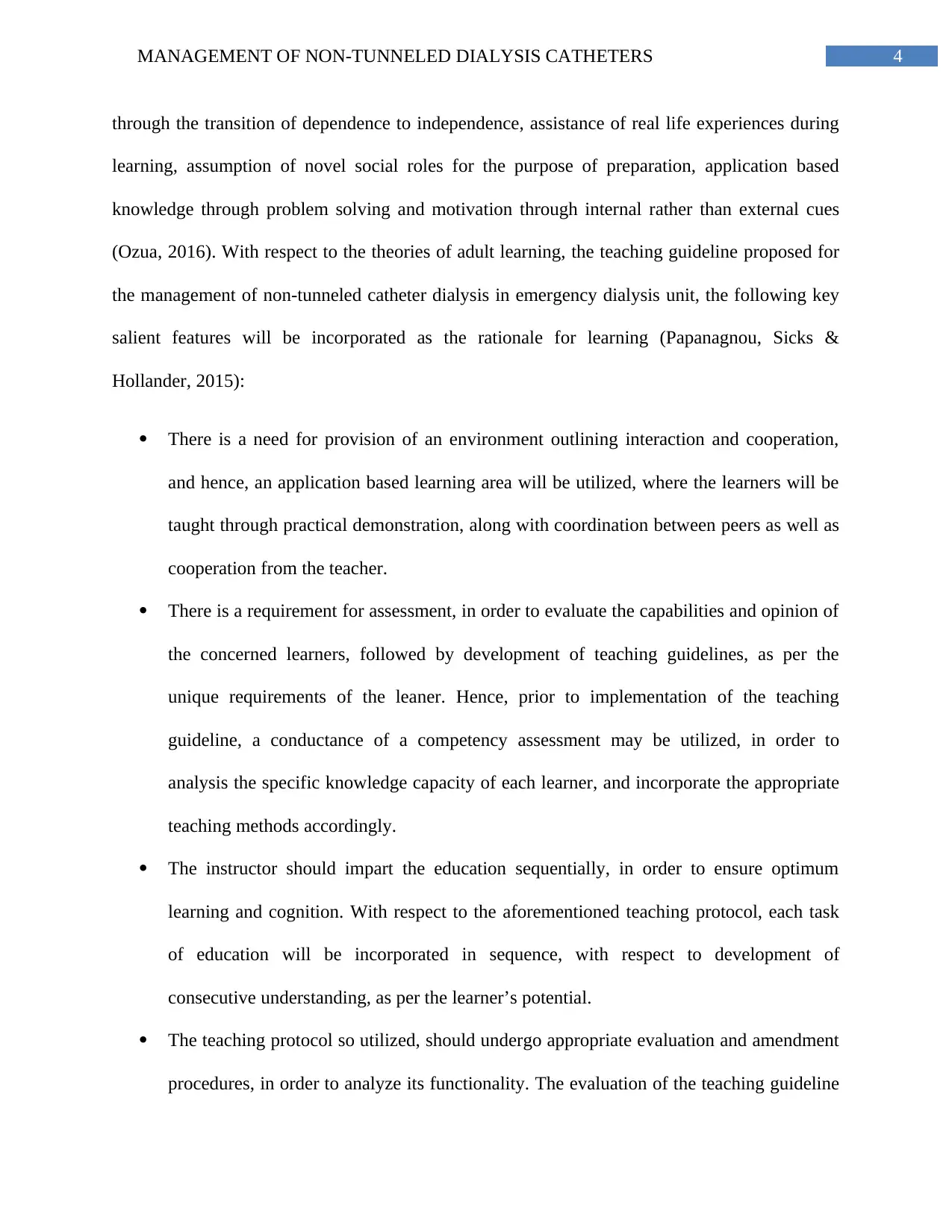
4MANAGEMENT OF NON-TUNNELED DIALYSIS CATHETERS
through the transition of dependence to independence, assistance of real life experiences during
learning, assumption of novel social roles for the purpose of preparation, application based
knowledge through problem solving and motivation through internal rather than external cues
(Ozua, 2016). With respect to the theories of adult learning, the teaching guideline proposed for
the management of non-tunneled catheter dialysis in emergency dialysis unit, the following key
salient features will be incorporated as the rationale for learning (Papanagnou, Sicks &
Hollander, 2015):
There is a need for provision of an environment outlining interaction and cooperation,
and hence, an application based learning area will be utilized, where the learners will be
taught through practical demonstration, along with coordination between peers as well as
cooperation from the teacher.
There is a requirement for assessment, in order to evaluate the capabilities and opinion of
the concerned learners, followed by development of teaching guidelines, as per the
unique requirements of the leaner. Hence, prior to implementation of the teaching
guideline, a conductance of a competency assessment may be utilized, in order to
analysis the specific knowledge capacity of each learner, and incorporate the appropriate
teaching methods accordingly.
The instructor should impart the education sequentially, in order to ensure optimum
learning and cognition. With respect to the aforementioned teaching protocol, each task
of education will be incorporated in sequence, with respect to development of
consecutive understanding, as per the learner’s potential.
The teaching protocol so utilized, should undergo appropriate evaluation and amendment
procedures, in order to analyze its functionality. The evaluation of the teaching guideline
through the transition of dependence to independence, assistance of real life experiences during
learning, assumption of novel social roles for the purpose of preparation, application based
knowledge through problem solving and motivation through internal rather than external cues
(Ozua, 2016). With respect to the theories of adult learning, the teaching guideline proposed for
the management of non-tunneled catheter dialysis in emergency dialysis unit, the following key
salient features will be incorporated as the rationale for learning (Papanagnou, Sicks &
Hollander, 2015):
There is a need for provision of an environment outlining interaction and cooperation,
and hence, an application based learning area will be utilized, where the learners will be
taught through practical demonstration, along with coordination between peers as well as
cooperation from the teacher.
There is a requirement for assessment, in order to evaluate the capabilities and opinion of
the concerned learners, followed by development of teaching guidelines, as per the
unique requirements of the leaner. Hence, prior to implementation of the teaching
guideline, a conductance of a competency assessment may be utilized, in order to
analysis the specific knowledge capacity of each learner, and incorporate the appropriate
teaching methods accordingly.
The instructor should impart the education sequentially, in order to ensure optimum
learning and cognition. With respect to the aforementioned teaching protocol, each task
of education will be incorporated in sequence, with respect to development of
consecutive understanding, as per the learner’s potential.
The teaching protocol so utilized, should undergo appropriate evaluation and amendment
procedures, in order to analyze its functionality. The evaluation of the teaching guideline
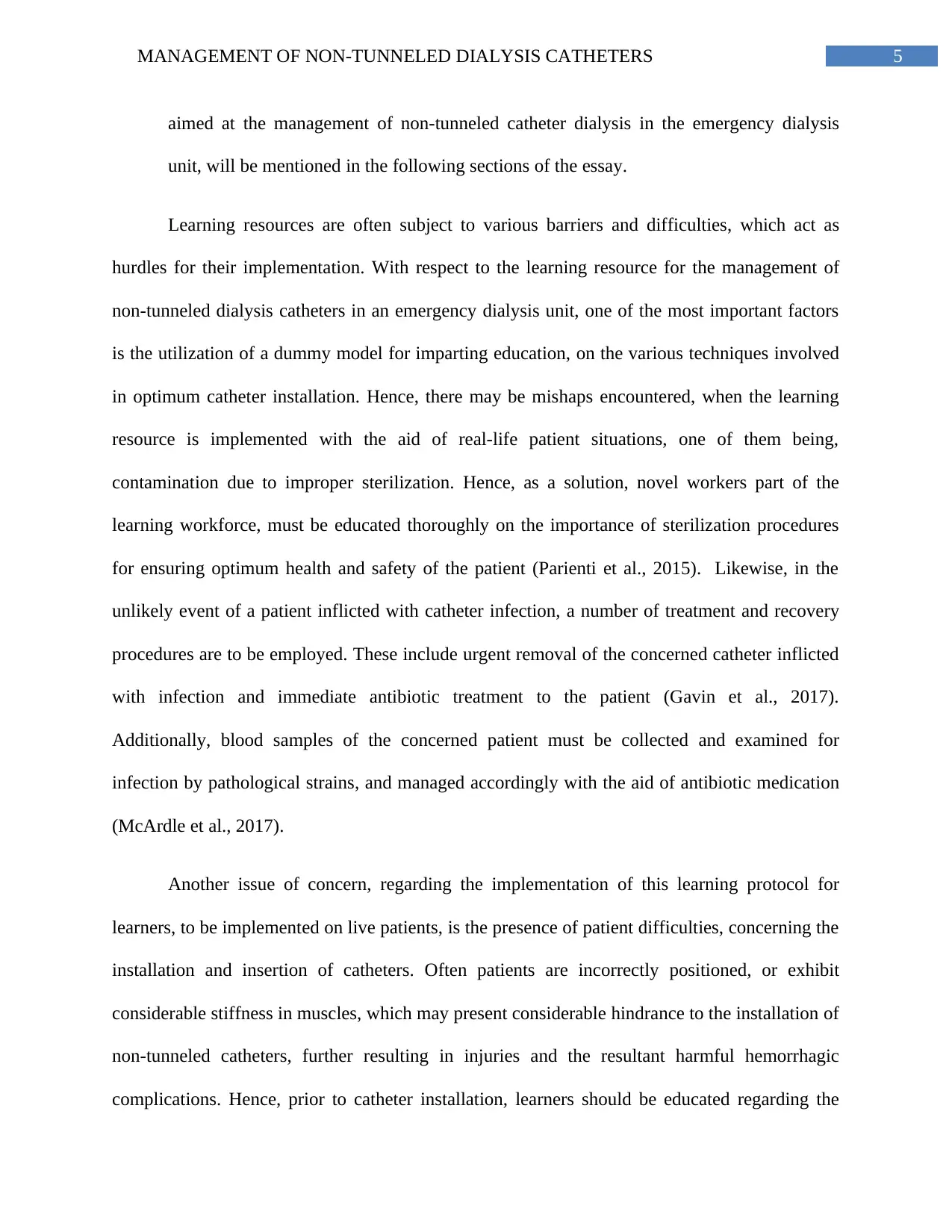
5MANAGEMENT OF NON-TUNNELED DIALYSIS CATHETERS
aimed at the management of non-tunneled catheter dialysis in the emergency dialysis
unit, will be mentioned in the following sections of the essay.
Learning resources are often subject to various barriers and difficulties, which act as
hurdles for their implementation. With respect to the learning resource for the management of
non-tunneled dialysis catheters in an emergency dialysis unit, one of the most important factors
is the utilization of a dummy model for imparting education, on the various techniques involved
in optimum catheter installation. Hence, there may be mishaps encountered, when the learning
resource is implemented with the aid of real-life patient situations, one of them being,
contamination due to improper sterilization. Hence, as a solution, novel workers part of the
learning workforce, must be educated thoroughly on the importance of sterilization procedures
for ensuring optimum health and safety of the patient (Parienti et al., 2015). Likewise, in the
unlikely event of a patient inflicted with catheter infection, a number of treatment and recovery
procedures are to be employed. These include urgent removal of the concerned catheter inflicted
with infection and immediate antibiotic treatment to the patient (Gavin et al., 2017).
Additionally, blood samples of the concerned patient must be collected and examined for
infection by pathological strains, and managed accordingly with the aid of antibiotic medication
(McArdle et al., 2017).
Another issue of concern, regarding the implementation of this learning protocol for
learners, to be implemented on live patients, is the presence of patient difficulties, concerning the
installation and insertion of catheters. Often patients are incorrectly positioned, or exhibit
considerable stiffness in muscles, which may present considerable hindrance to the installation of
non-tunneled catheters, further resulting in injuries and the resultant harmful hemorrhagic
complications. Hence, prior to catheter installation, learners should be educated regarding the
aimed at the management of non-tunneled catheter dialysis in the emergency dialysis
unit, will be mentioned in the following sections of the essay.
Learning resources are often subject to various barriers and difficulties, which act as
hurdles for their implementation. With respect to the learning resource for the management of
non-tunneled dialysis catheters in an emergency dialysis unit, one of the most important factors
is the utilization of a dummy model for imparting education, on the various techniques involved
in optimum catheter installation. Hence, there may be mishaps encountered, when the learning
resource is implemented with the aid of real-life patient situations, one of them being,
contamination due to improper sterilization. Hence, as a solution, novel workers part of the
learning workforce, must be educated thoroughly on the importance of sterilization procedures
for ensuring optimum health and safety of the patient (Parienti et al., 2015). Likewise, in the
unlikely event of a patient inflicted with catheter infection, a number of treatment and recovery
procedures are to be employed. These include urgent removal of the concerned catheter inflicted
with infection and immediate antibiotic treatment to the patient (Gavin et al., 2017).
Additionally, blood samples of the concerned patient must be collected and examined for
infection by pathological strains, and managed accordingly with the aid of antibiotic medication
(McArdle et al., 2017).
Another issue of concern, regarding the implementation of this learning protocol for
learners, to be implemented on live patients, is the presence of patient difficulties, concerning the
installation and insertion of catheters. Often patients are incorrectly positioned, or exhibit
considerable stiffness in muscles, which may present considerable hindrance to the installation of
non-tunneled catheters, further resulting in injuries and the resultant harmful hemorrhagic
complications. Hence, prior to catheter installation, learners should be educated regarding the
⊘ This is a preview!⊘
Do you want full access?
Subscribe today to unlock all pages.

Trusted by 1+ million students worldwide
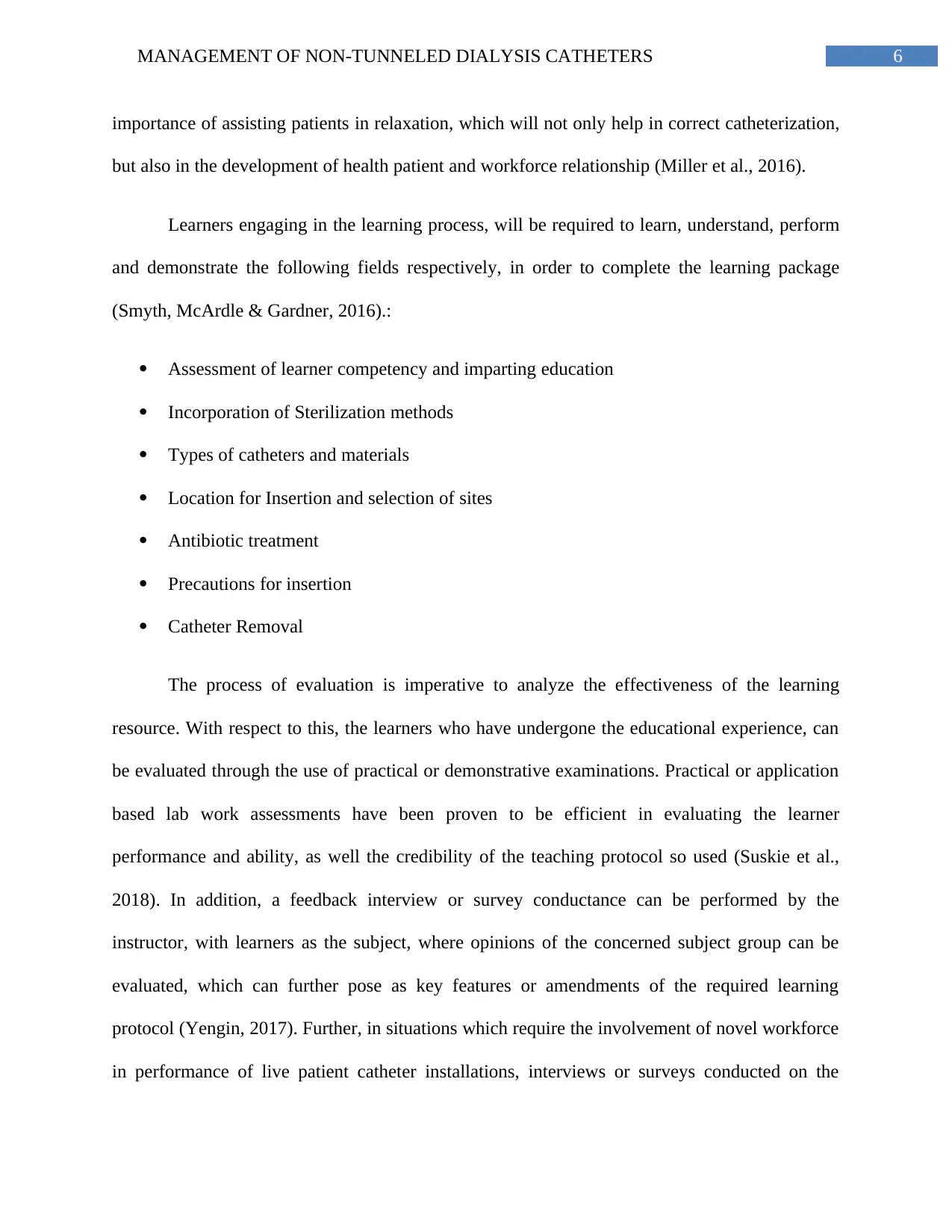
6MANAGEMENT OF NON-TUNNELED DIALYSIS CATHETERS
importance of assisting patients in relaxation, which will not only help in correct catheterization,
but also in the development of health patient and workforce relationship (Miller et al., 2016).
Learners engaging in the learning process, will be required to learn, understand, perform
and demonstrate the following fields respectively, in order to complete the learning package
(Smyth, McArdle & Gardner, 2016).:
Assessment of learner competency and imparting education
Incorporation of Sterilization methods
Types of catheters and materials
Location for Insertion and selection of sites
Antibiotic treatment
Precautions for insertion
Catheter Removal
The process of evaluation is imperative to analyze the effectiveness of the learning
resource. With respect to this, the learners who have undergone the educational experience, can
be evaluated through the use of practical or demonstrative examinations. Practical or application
based lab work assessments have been proven to be efficient in evaluating the learner
performance and ability, as well the credibility of the teaching protocol so used (Suskie et al.,
2018). In addition, a feedback interview or survey conductance can be performed by the
instructor, with learners as the subject, where opinions of the concerned subject group can be
evaluated, which can further pose as key features or amendments of the required learning
protocol (Yengin, 2017). Further, in situations which require the involvement of novel workforce
in performance of live patient catheter installations, interviews or surveys conducted on the
importance of assisting patients in relaxation, which will not only help in correct catheterization,
but also in the development of health patient and workforce relationship (Miller et al., 2016).
Learners engaging in the learning process, will be required to learn, understand, perform
and demonstrate the following fields respectively, in order to complete the learning package
(Smyth, McArdle & Gardner, 2016).:
Assessment of learner competency and imparting education
Incorporation of Sterilization methods
Types of catheters and materials
Location for Insertion and selection of sites
Antibiotic treatment
Precautions for insertion
Catheter Removal
The process of evaluation is imperative to analyze the effectiveness of the learning
resource. With respect to this, the learners who have undergone the educational experience, can
be evaluated through the use of practical or demonstrative examinations. Practical or application
based lab work assessments have been proven to be efficient in evaluating the learner
performance and ability, as well the credibility of the teaching protocol so used (Suskie et al.,
2018). In addition, a feedback interview or survey conductance can be performed by the
instructor, with learners as the subject, where opinions of the concerned subject group can be
evaluated, which can further pose as key features or amendments of the required learning
protocol (Yengin, 2017). Further, in situations which require the involvement of novel workforce
in performance of live patient catheter installations, interviews or surveys conducted on the
Paraphrase This Document
Need a fresh take? Get an instant paraphrase of this document with our AI Paraphraser
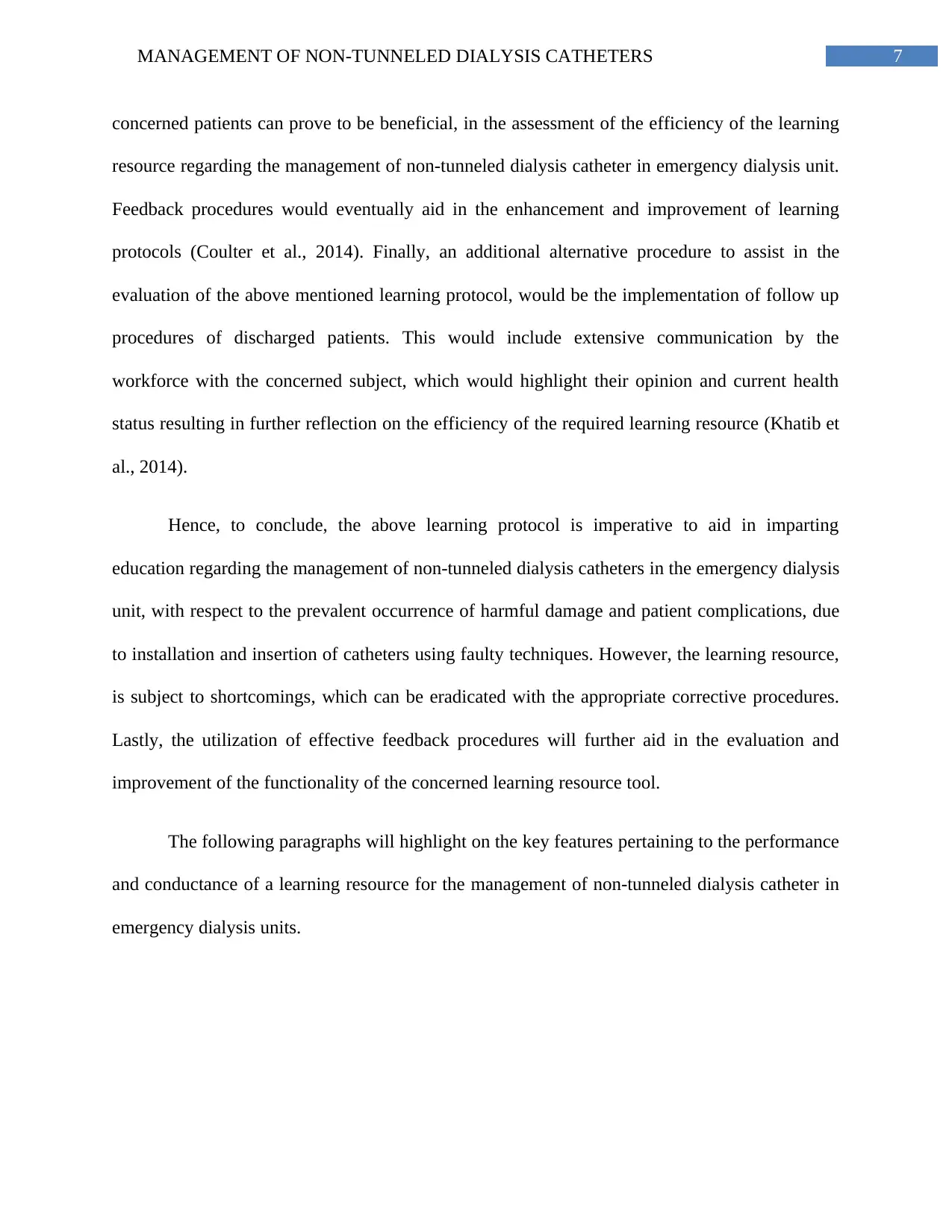
7MANAGEMENT OF NON-TUNNELED DIALYSIS CATHETERS
concerned patients can prove to be beneficial, in the assessment of the efficiency of the learning
resource regarding the management of non-tunneled dialysis catheter in emergency dialysis unit.
Feedback procedures would eventually aid in the enhancement and improvement of learning
protocols (Coulter et al., 2014). Finally, an additional alternative procedure to assist in the
evaluation of the above mentioned learning protocol, would be the implementation of follow up
procedures of discharged patients. This would include extensive communication by the
workforce with the concerned subject, which would highlight their opinion and current health
status resulting in further reflection on the efficiency of the required learning resource (Khatib et
al., 2014).
Hence, to conclude, the above learning protocol is imperative to aid in imparting
education regarding the management of non-tunneled dialysis catheters in the emergency dialysis
unit, with respect to the prevalent occurrence of harmful damage and patient complications, due
to installation and insertion of catheters using faulty techniques. However, the learning resource,
is subject to shortcomings, which can be eradicated with the appropriate corrective procedures.
Lastly, the utilization of effective feedback procedures will further aid in the evaluation and
improvement of the functionality of the concerned learning resource tool.
The following paragraphs will highlight on the key features pertaining to the performance
and conductance of a learning resource for the management of non-tunneled dialysis catheter in
emergency dialysis units.
concerned patients can prove to be beneficial, in the assessment of the efficiency of the learning
resource regarding the management of non-tunneled dialysis catheter in emergency dialysis unit.
Feedback procedures would eventually aid in the enhancement and improvement of learning
protocols (Coulter et al., 2014). Finally, an additional alternative procedure to assist in the
evaluation of the above mentioned learning protocol, would be the implementation of follow up
procedures of discharged patients. This would include extensive communication by the
workforce with the concerned subject, which would highlight their opinion and current health
status resulting in further reflection on the efficiency of the required learning resource (Khatib et
al., 2014).
Hence, to conclude, the above learning protocol is imperative to aid in imparting
education regarding the management of non-tunneled dialysis catheters in the emergency dialysis
unit, with respect to the prevalent occurrence of harmful damage and patient complications, due
to installation and insertion of catheters using faulty techniques. However, the learning resource,
is subject to shortcomings, which can be eradicated with the appropriate corrective procedures.
Lastly, the utilization of effective feedback procedures will further aid in the evaluation and
improvement of the functionality of the concerned learning resource tool.
The following paragraphs will highlight on the key features pertaining to the performance
and conductance of a learning resource for the management of non-tunneled dialysis catheter in
emergency dialysis units.
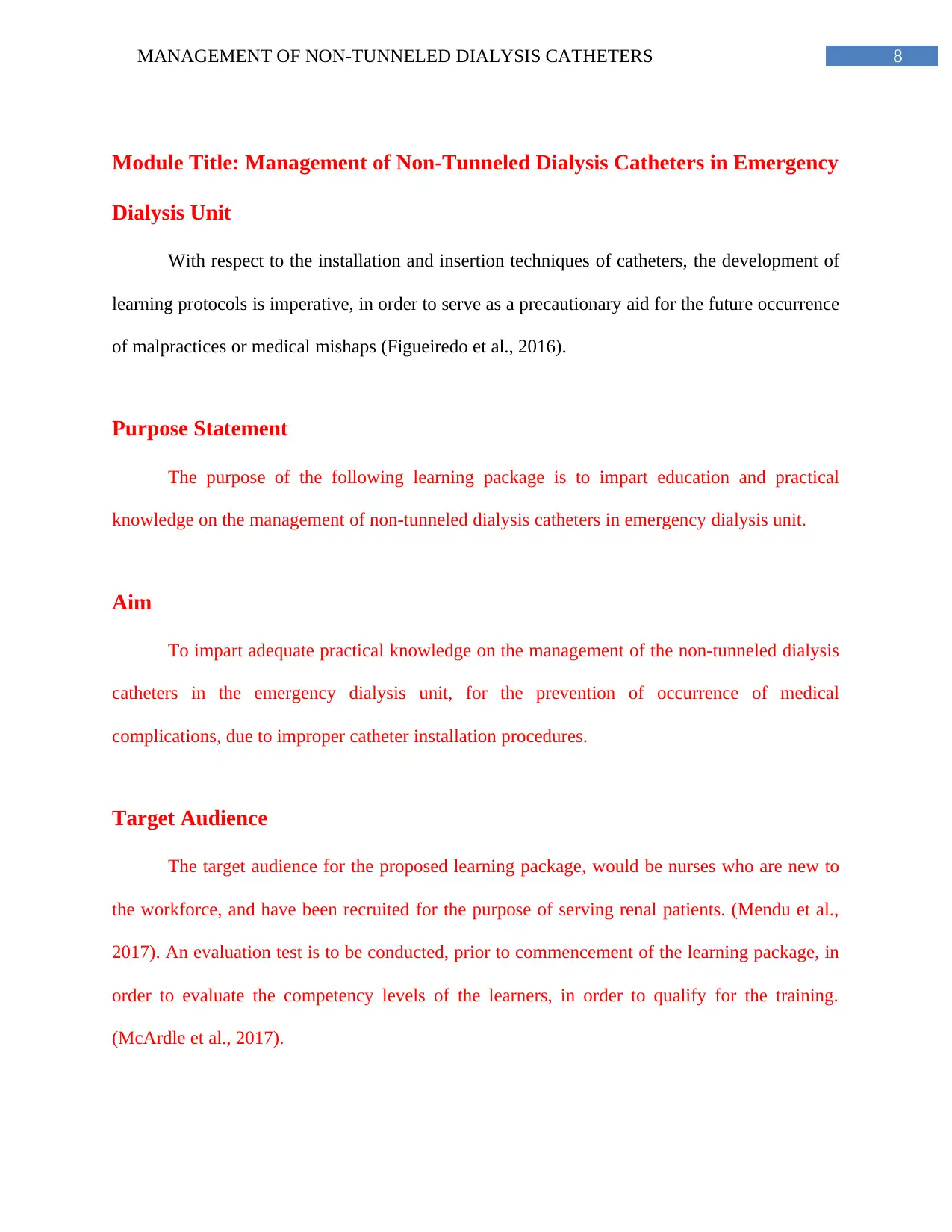
8MANAGEMENT OF NON-TUNNELED DIALYSIS CATHETERS
Module Title: Management of Non-Tunneled Dialysis Catheters in Emergency
Dialysis Unit
With respect to the installation and insertion techniques of catheters, the development of
learning protocols is imperative, in order to serve as a precautionary aid for the future occurrence
of malpractices or medical mishaps (Figueiredo et al., 2016).
Purpose Statement
The purpose of the following learning package is to impart education and practical
knowledge on the management of non-tunneled dialysis catheters in emergency dialysis unit.
Aim
To impart adequate practical knowledge on the management of the non-tunneled dialysis
catheters in the emergency dialysis unit, for the prevention of occurrence of medical
complications, due to improper catheter installation procedures.
Target Audience
The target audience for the proposed learning package, would be nurses who are new to
the workforce, and have been recruited for the purpose of serving renal patients. (Mendu et al.,
2017). An evaluation test is to be conducted, prior to commencement of the learning package, in
order to evaluate the competency levels of the learners, in order to qualify for the training.
(McArdle et al., 2017).
Module Title: Management of Non-Tunneled Dialysis Catheters in Emergency
Dialysis Unit
With respect to the installation and insertion techniques of catheters, the development of
learning protocols is imperative, in order to serve as a precautionary aid for the future occurrence
of malpractices or medical mishaps (Figueiredo et al., 2016).
Purpose Statement
The purpose of the following learning package is to impart education and practical
knowledge on the management of non-tunneled dialysis catheters in emergency dialysis unit.
Aim
To impart adequate practical knowledge on the management of the non-tunneled dialysis
catheters in the emergency dialysis unit, for the prevention of occurrence of medical
complications, due to improper catheter installation procedures.
Target Audience
The target audience for the proposed learning package, would be nurses who are new to
the workforce, and have been recruited for the purpose of serving renal patients. (Mendu et al.,
2017). An evaluation test is to be conducted, prior to commencement of the learning package, in
order to evaluate the competency levels of the learners, in order to qualify for the training.
(McArdle et al., 2017).
⊘ This is a preview!⊘
Do you want full access?
Subscribe today to unlock all pages.

Trusted by 1+ million students worldwide
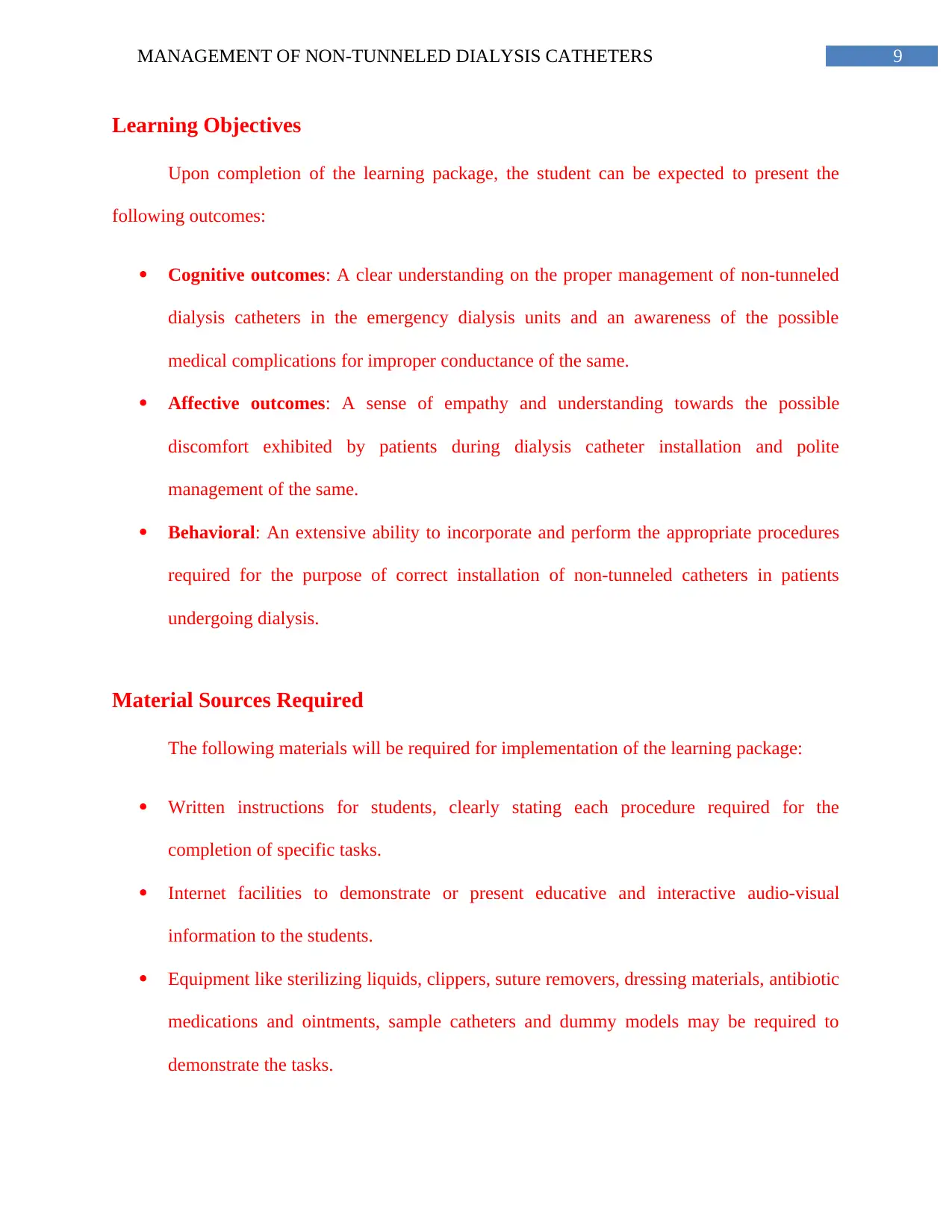
9MANAGEMENT OF NON-TUNNELED DIALYSIS CATHETERS
Learning Objectives
Upon completion of the learning package, the student can be expected to present the
following outcomes:
Cognitive outcomes: A clear understanding on the proper management of non-tunneled
dialysis catheters in the emergency dialysis units and an awareness of the possible
medical complications for improper conductance of the same.
Affective outcomes: A sense of empathy and understanding towards the possible
discomfort exhibited by patients during dialysis catheter installation and polite
management of the same.
Behavioral: An extensive ability to incorporate and perform the appropriate procedures
required for the purpose of correct installation of non-tunneled catheters in patients
undergoing dialysis.
Material Sources Required
The following materials will be required for implementation of the learning package:
Written instructions for students, clearly stating each procedure required for the
completion of specific tasks.
Internet facilities to demonstrate or present educative and interactive audio-visual
information to the students.
Equipment like sterilizing liquids, clippers, suture removers, dressing materials, antibiotic
medications and ointments, sample catheters and dummy models may be required to
demonstrate the tasks.
Learning Objectives
Upon completion of the learning package, the student can be expected to present the
following outcomes:
Cognitive outcomes: A clear understanding on the proper management of non-tunneled
dialysis catheters in the emergency dialysis units and an awareness of the possible
medical complications for improper conductance of the same.
Affective outcomes: A sense of empathy and understanding towards the possible
discomfort exhibited by patients during dialysis catheter installation and polite
management of the same.
Behavioral: An extensive ability to incorporate and perform the appropriate procedures
required for the purpose of correct installation of non-tunneled catheters in patients
undergoing dialysis.
Material Sources Required
The following materials will be required for implementation of the learning package:
Written instructions for students, clearly stating each procedure required for the
completion of specific tasks.
Internet facilities to demonstrate or present educative and interactive audio-visual
information to the students.
Equipment like sterilizing liquids, clippers, suture removers, dressing materials, antibiotic
medications and ointments, sample catheters and dummy models may be required to
demonstrate the tasks.
Paraphrase This Document
Need a fresh take? Get an instant paraphrase of this document with our AI Paraphraser
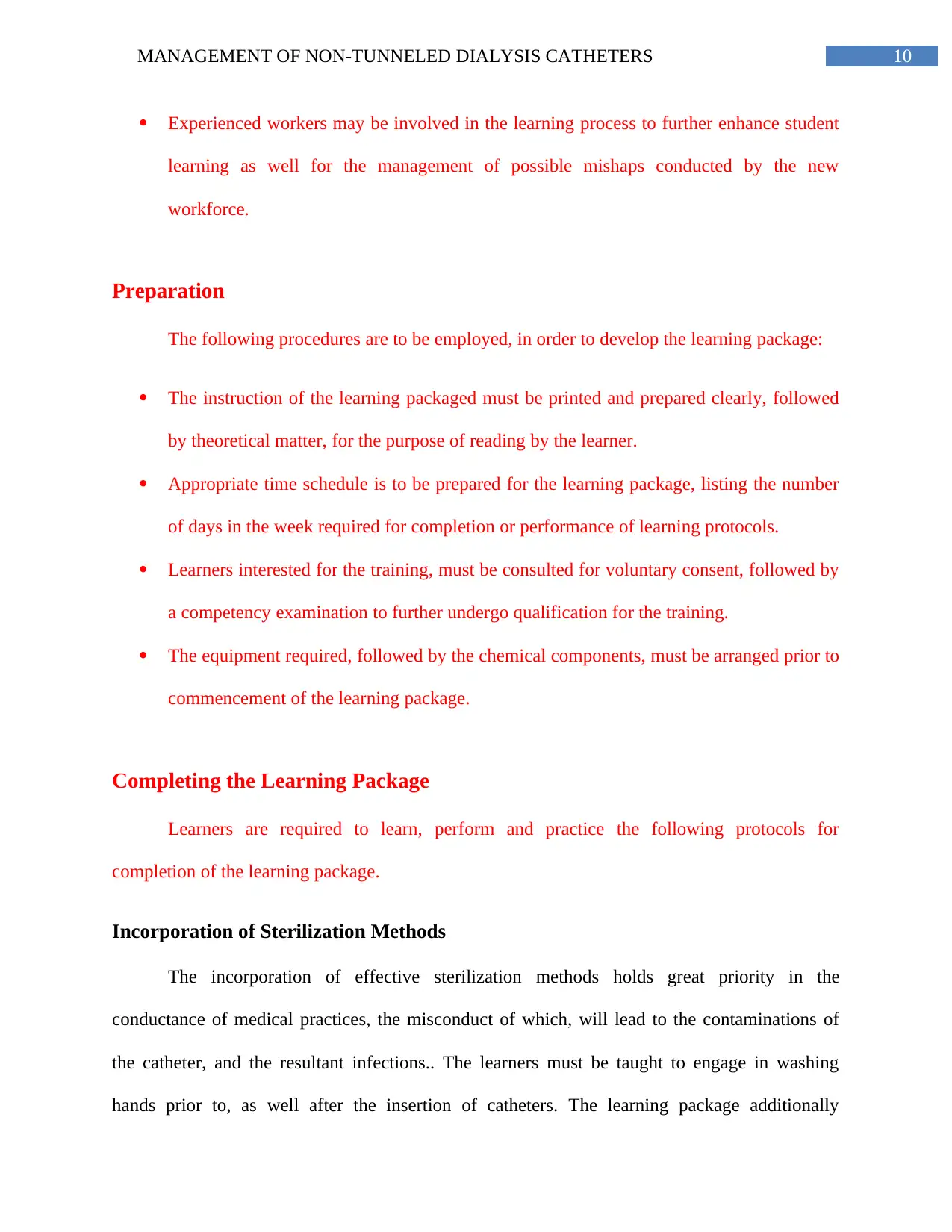
10MANAGEMENT OF NON-TUNNELED DIALYSIS CATHETERS
Experienced workers may be involved in the learning process to further enhance student
learning as well for the management of possible mishaps conducted by the new
workforce.
Preparation
The following procedures are to be employed, in order to develop the learning package:
The instruction of the learning packaged must be printed and prepared clearly, followed
by theoretical matter, for the purpose of reading by the learner.
Appropriate time schedule is to be prepared for the learning package, listing the number
of days in the week required for completion or performance of learning protocols.
Learners interested for the training, must be consulted for voluntary consent, followed by
a competency examination to further undergo qualification for the training.
The equipment required, followed by the chemical components, must be arranged prior to
commencement of the learning package.
Completing the Learning Package
Learners are required to learn, perform and practice the following protocols for
completion of the learning package.
Incorporation of Sterilization Methods
The incorporation of effective sterilization methods holds great priority in the
conductance of medical practices, the misconduct of which, will lead to the contaminations of
the catheter, and the resultant infections.. The learners must be taught to engage in washing
hands prior to, as well after the insertion of catheters. The learning package additionally
Experienced workers may be involved in the learning process to further enhance student
learning as well for the management of possible mishaps conducted by the new
workforce.
Preparation
The following procedures are to be employed, in order to develop the learning package:
The instruction of the learning packaged must be printed and prepared clearly, followed
by theoretical matter, for the purpose of reading by the learner.
Appropriate time schedule is to be prepared for the learning package, listing the number
of days in the week required for completion or performance of learning protocols.
Learners interested for the training, must be consulted for voluntary consent, followed by
a competency examination to further undergo qualification for the training.
The equipment required, followed by the chemical components, must be arranged prior to
commencement of the learning package.
Completing the Learning Package
Learners are required to learn, perform and practice the following protocols for
completion of the learning package.
Incorporation of Sterilization Methods
The incorporation of effective sterilization methods holds great priority in the
conductance of medical practices, the misconduct of which, will lead to the contaminations of
the catheter, and the resultant infections.. The learners must be taught to engage in washing
hands prior to, as well after the insertion of catheters. The learning package additionally
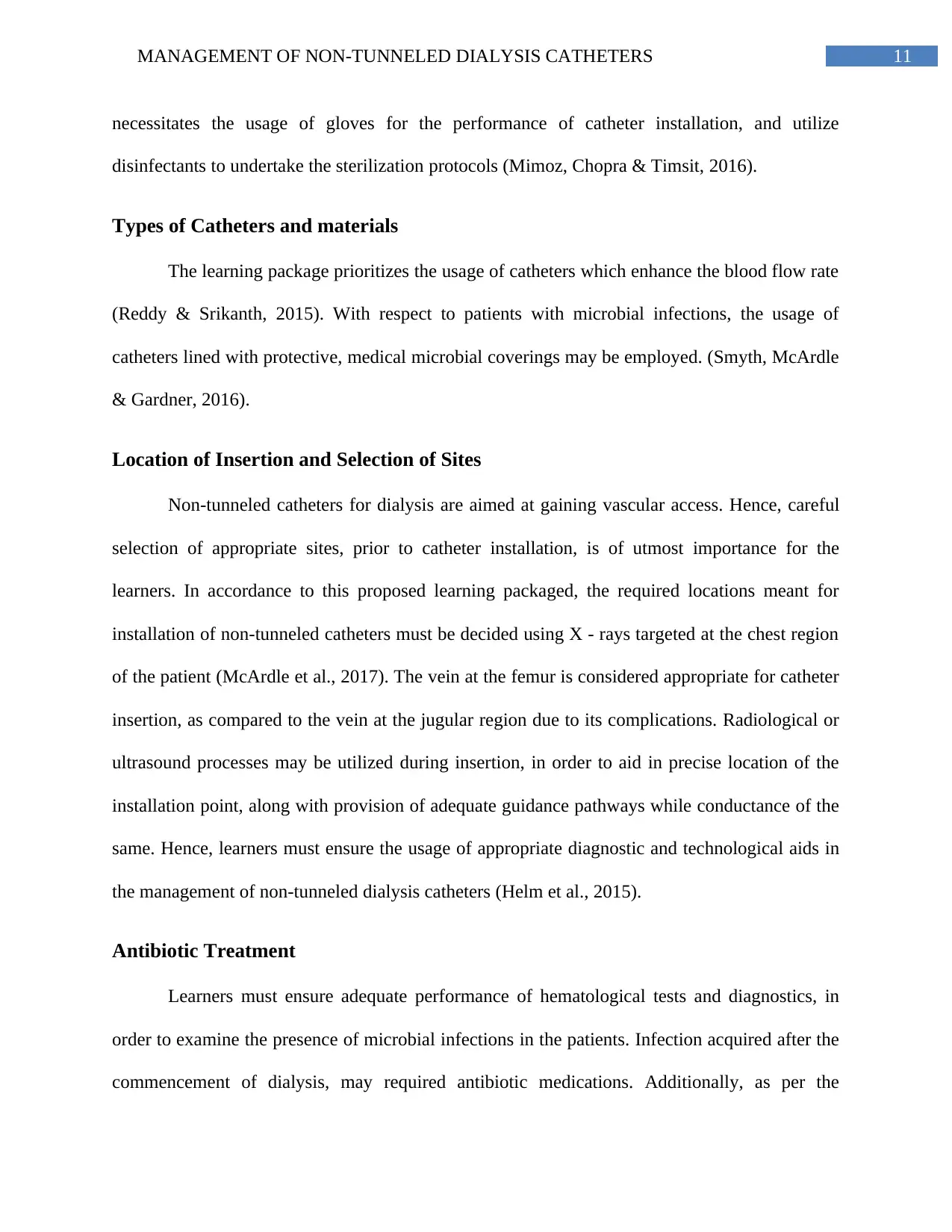
11MANAGEMENT OF NON-TUNNELED DIALYSIS CATHETERS
necessitates the usage of gloves for the performance of catheter installation, and utilize
disinfectants to undertake the sterilization protocols (Mimoz, Chopra & Timsit, 2016).
Types of Catheters and materials
The learning package prioritizes the usage of catheters which enhance the blood flow rate
(Reddy & Srikanth, 2015). With respect to patients with microbial infections, the usage of
catheters lined with protective, medical microbial coverings may be employed. (Smyth, McArdle
& Gardner, 2016).
Location of Insertion and Selection of Sites
Non-tunneled catheters for dialysis are aimed at gaining vascular access. Hence, careful
selection of appropriate sites, prior to catheter installation, is of utmost importance for the
learners. In accordance to this proposed learning packaged, the required locations meant for
installation of non-tunneled catheters must be decided using X - rays targeted at the chest region
of the patient (McArdle et al., 2017). The vein at the femur is considered appropriate for catheter
insertion, as compared to the vein at the jugular region due to its complications. Radiological or
ultrasound processes may be utilized during insertion, in order to aid in precise location of the
installation point, along with provision of adequate guidance pathways while conductance of the
same. Hence, learners must ensure the usage of appropriate diagnostic and technological aids in
the management of non-tunneled dialysis catheters (Helm et al., 2015).
Antibiotic Treatment
Learners must ensure adequate performance of hematological tests and diagnostics, in
order to examine the presence of microbial infections in the patients. Infection acquired after the
commencement of dialysis, may required antibiotic medications. Additionally, as per the
necessitates the usage of gloves for the performance of catheter installation, and utilize
disinfectants to undertake the sterilization protocols (Mimoz, Chopra & Timsit, 2016).
Types of Catheters and materials
The learning package prioritizes the usage of catheters which enhance the blood flow rate
(Reddy & Srikanth, 2015). With respect to patients with microbial infections, the usage of
catheters lined with protective, medical microbial coverings may be employed. (Smyth, McArdle
& Gardner, 2016).
Location of Insertion and Selection of Sites
Non-tunneled catheters for dialysis are aimed at gaining vascular access. Hence, careful
selection of appropriate sites, prior to catheter installation, is of utmost importance for the
learners. In accordance to this proposed learning packaged, the required locations meant for
installation of non-tunneled catheters must be decided using X - rays targeted at the chest region
of the patient (McArdle et al., 2017). The vein at the femur is considered appropriate for catheter
insertion, as compared to the vein at the jugular region due to its complications. Radiological or
ultrasound processes may be utilized during insertion, in order to aid in precise location of the
installation point, along with provision of adequate guidance pathways while conductance of the
same. Hence, learners must ensure the usage of appropriate diagnostic and technological aids in
the management of non-tunneled dialysis catheters (Helm et al., 2015).
Antibiotic Treatment
Learners must ensure adequate performance of hematological tests and diagnostics, in
order to examine the presence of microbial infections in the patients. Infection acquired after the
commencement of dialysis, may required antibiotic medications. Additionally, as per the
⊘ This is a preview!⊘
Do you want full access?
Subscribe today to unlock all pages.

Trusted by 1+ million students worldwide
1 out of 18
Related Documents
Your All-in-One AI-Powered Toolkit for Academic Success.
+13062052269
info@desklib.com
Available 24*7 on WhatsApp / Email
![[object Object]](/_next/static/media/star-bottom.7253800d.svg)
Unlock your academic potential
Copyright © 2020–2025 A2Z Services. All Rights Reserved. Developed and managed by ZUCOL.





